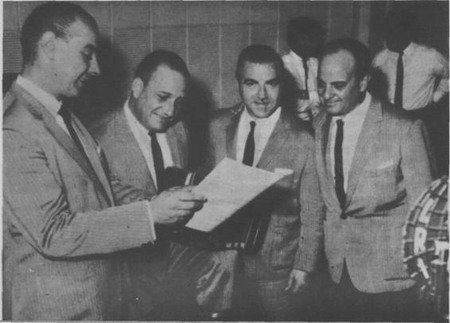10a) Florindo Sassone and his Orquesta Típica (until 1972)
Florindo Sassone's musical rendering is often described as a blend of Fresedo and Di Sarli, yet this characterization oversimplifies his unique style. He delivers an elegant violin phrasing complemented by symbolic harp embellishments, accompanied by a quasi-Di Sarlian but lighter accentuation and arrastre. However, the aloofness even abstinence flavor in his music distinguished him, making him notably distinct from both the mental self-destructive inclination of the Tango Lord and the elitism and bourgeoisie associated with the Tango Patrician.
While many of his peers faded from the spotlight in the 1960s, Sassone partnered with Roberto Guisado and some other Di Sarli's violinists after the maestro’ demise, propelling him into a brilliant phase of his career lasting over a decade. This period included two successful tours to Japan in 1966 and 1972. Notably, Sassone produced a vast collection of recordings during this time, featuring a diverse repertoire of popular music from Europe, America, and Japan, all transcribed into tango style.
Sassone’s RCA era (pre-1956) suffers from tech transition and the quality is generally bad. His Odeón era (1959-70) and Carmusic era (1971) have his best recordings.
Must-haves: (9 albums)
These three (DBN BM1, BM2, GTA) albums covered most Sassone’s recordings from 1959-1966. However non-Argentine themes are all taken out. Probably EMI considered them unsuitable for Argentine market.
DBN Tangos de Siempre Vol.4
Six lovely 1968 Instrumentals.
EM: Las 1001 Noches del Tango
A huge compilation. Some instrumental transfers have surpassed the DBN series.
Carmusic 19001: Tango International (ESPA TI)
According to the liner notes, these 36 tunes (24 Europe/US songs + 12 Japanese songs) were specially tailored and recorded in 1971 for release before Sassone’s 1972 Japan trip, including the famous Pescadores De Perlas (1971).
AMP 1139: Florindo Sassone y su Orquesta Tipica
Very solid RCA-era shellac transfers.
EM FATW: Florindo Sassone
Early Odeón instrumentals. Some transfers are superior to those in DBN catalogue.
EM CP32-9033: Continental Tango
Ten 1968 Instrumentals of international themes.
Carmusic 70002: Tango de Oro (ESPA TdO)
Also from the 1971 recording session, 12 Argentine traditional tango themes.
EU 16021: Florindo Sassone y sus cantores
Compilation of RCA-era recordings, mostly LP transfers. Many problems though.
Could Haves:
BATC Vol.8: Florindo Sassone
Some Casal and Chanel options.
RCA GHTA Vol.7: Gran Historia del Tango Argentino
The best transfer of El Relámpago and La Trilla (1951).
LanTower Vol.46 (LT 46):
For Maipo, Mambo, and BsAs de Antaño.
RCA Club: Florindo Sassone
Some Casal and Galé options.
EM CP32-5142: Los Mejores de Florindo Sassone
Carrillón de la Merced, and some other 66 instrumentals tracks are arguably better than DBN GTA with more emphasis on the string section during mastering.
The List:
Casal, Chanel (RCA)
Malbrán, Lavalle, Galé (RCA)
Instrumentals 1949-56 (RCA)
Singers 1959-70 (Odeón)
Instrumentals 1959-66 (Odeón)
Instrumentals 1968-70 (Odeón)
Instrumentals 1971 (Carmusic)
10b) Miguel Caló and his Orquesta Típica
If we were to rank the 6th best OT, following JD, CdS, OP, AT, and FC, I would argue that Miguel Caló deserves a significant share of the votes. Caló is also the third most important figure in the romantic tango school, after OF and CdS. With top-notch talents, musicians, and singers in his ensemble, Caló had all the cards for success. The only question that remains is why he couldn't be one of the immortals.
There are likely two reasons. Firstly, all of his musicians were well-trained, polite young men from the provinces, who perhaps appeared too "clean" for tango, reflected in the orchestra's neat, academic, somewhat straightforward, and naive style of interpretation.
Another factor could be Caló's personality: he wasn't a controlling tyrant, obnoxious perfectionist, narcissistic ideologue, pampered neighborhood boy, or corrupt capitalist. As a result, band members would depart, and Caló himself struggled to make his orquesta greatest again. Nonetheless, he played a crucial role in nurturing some of the most successful musicians in tango history, not to mention all the big names.
His influence was ubiquitous across Latin America, making it exceedingly challenging for collectors to obtain his complete discography. Here, we narrow our focus to his performances within his homeland border.
Must-haves: (6 albums)
DBN: Despues de las Estrellas (DBN DDLE)
Singers 1949-1952. Good LP transfers.
El Bandoneon 034: Miguel Caló y sus Orquesta Tipica
The most valuable CD of all El Bandoneon series. Unbeatable transfers of Podestá. Taggings are terrible but content prevails. Must-have for DJs!
EU 19003: Bailando con Caló
Instrumentals of the 1960s. Master tape transfers.
EM: From Argentina to World, Miguel Caló
Instrumentals of the 1950s. Good LP transfers.
EM MCLE: Miguel Caló y sus Orquesta De Las Estrellas
Unofficial CD transfer of the LP, featuring the 1963 reunion of the “Estrellas”.
EU 19015: Miguel Caló y sus Cantores
Another must-have for DJs. Just couldn’t get enough of them
Could Haves:
AMP 1250: Lejos de BsAs
La Guitarra.
Danza y Movimiento Vol.227
Café para Dos and Encandenados.
EM TOTC-5870: Los Mejores de Ranko Fujisawa
Six lovely Fujisawa tunes.
AMP 1284: Realidad de Tango Vol.10
The last Podestá piece: Oración Rante.
EM JT: Juan Tango
Un Infierno by Podestá.
Los Clasicos Argentinos VII (LCA VII)
Noche de locura by Podestá.
The List (not including Brazil, Chile, Chile, and Perú Odeón recordings):
Instrumentals
Singers 1949-53
Singers 1954-58
Singers 1963-64













































